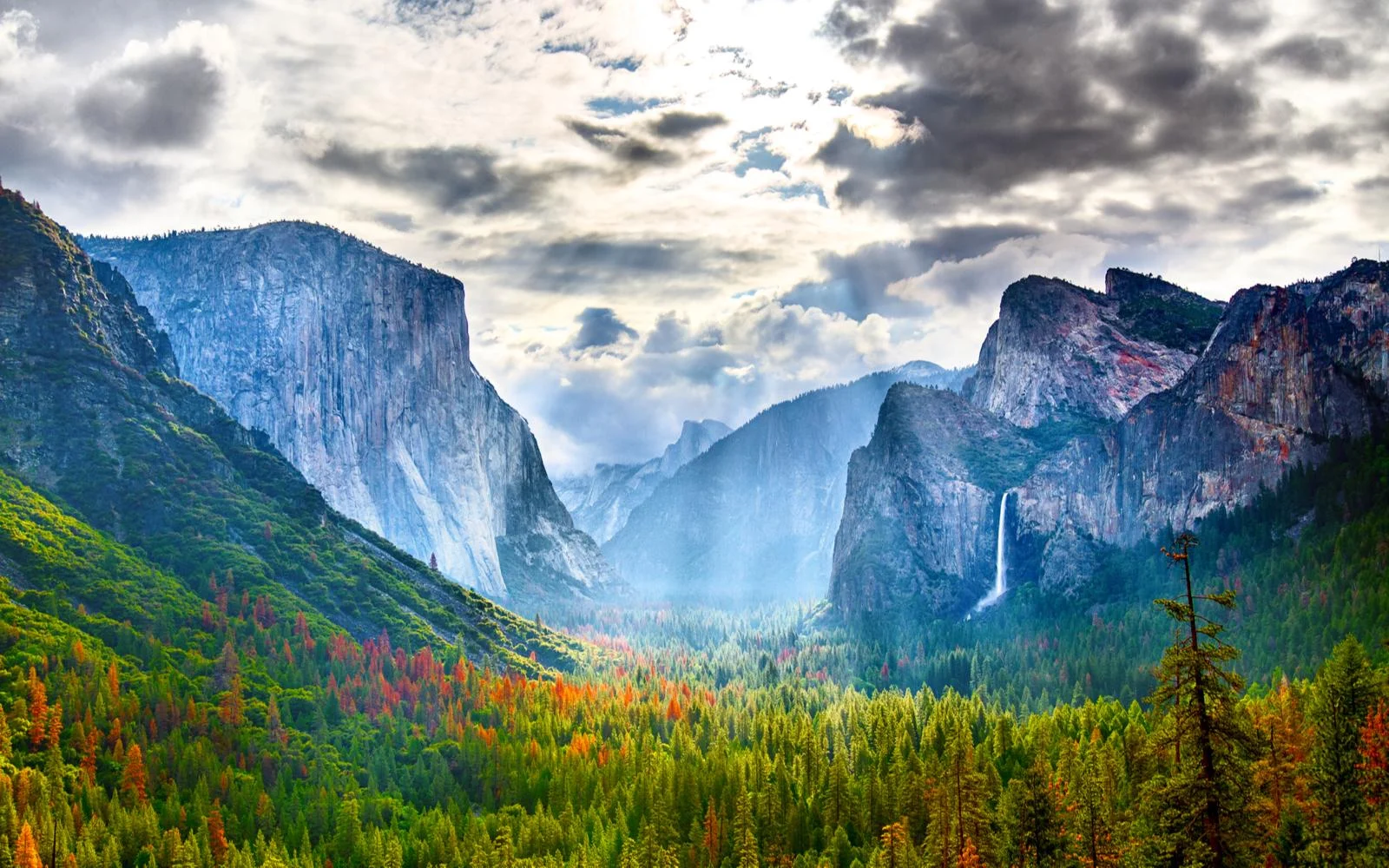What's the best time to visit Yosemite?
Yosemite National Park is home to iconic views and vistas, giant sequoias, towering granite cliffs and domes, and deeply carved valleys that make it one of the most beautiful national parks to visit.
Find out the best time to visit Yosemite in our quick travel guide, no matter what your goals for the trip are! If you want to go when the weather is perfect and park activities and tours are in full swing, check out the overall best time to visit Yosemite below.
Budget-conscious travelers will want to know the cheapest time of year to go. And those who want to avoid the biggest crowds of peak season will appreciate knowing the least busy time of year to visit!
It’s all here in our guide, along with helpful travel tips to make the most of your trip. But first, an introduction to what makes Yosemite National Park special and why you need to visit.
The Overall Best Time to Visit Yosemite
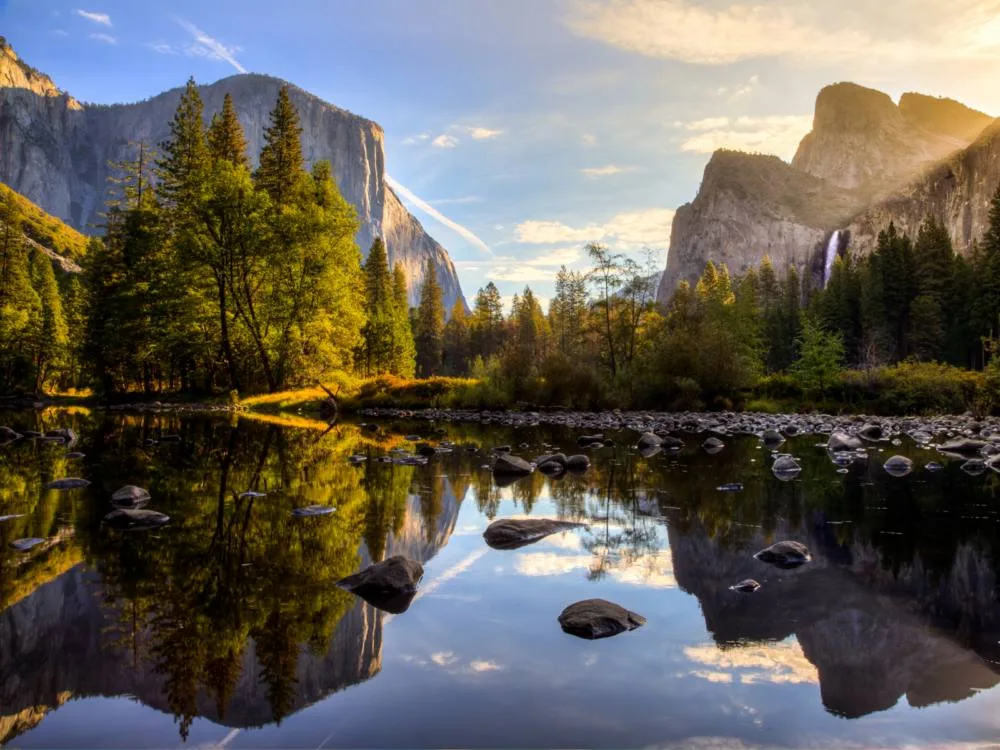
Diego Grandi/Shutterstock
The overall best time to visit Yosemite is May through September, with May, June, and September being the ideal times to visit. Planning your visit during this time allows you to avoid 95% of the year’s rain in Yosemite.
You’ll enjoy warm, dry weather with all the conveniences of the park’s services, roads, and lodging being open during this time. This is the peak season for Yosemite – about 75% of the annual park visitors arrive from May to September/October.
You’ll definitely see bigger crowds at this time of year, but all the benefits of spring, summer, and early fall make it worth it. Every shuttle, road, trail, and area of the park is open during this time.
The cascading falls are powerfully flowing after the rain and snow melt from the winter and early spring. Attractions are running at full speed with lots of tours, guided hikes, and daily activities occurring in the warm months.
You’ll have the most lodging options during this time – just book early to avoid running into “no vacancy” roadblocks as the peak season approaches.
Camping is perfect during these warm and sunny months, when the temperatures range from a comfortable high of 70F-80F in May, June, and September to sizzling highs around 90 in July and August.
Don't waste your hard-earned money. Get the best deal on your trip by comparing deals on Booking.com and Expedia!
- Options for all travel styles & budgets
- Price match guarantees
- Exclusive last-minute deals
Cheapest Time to Visit Yosemite
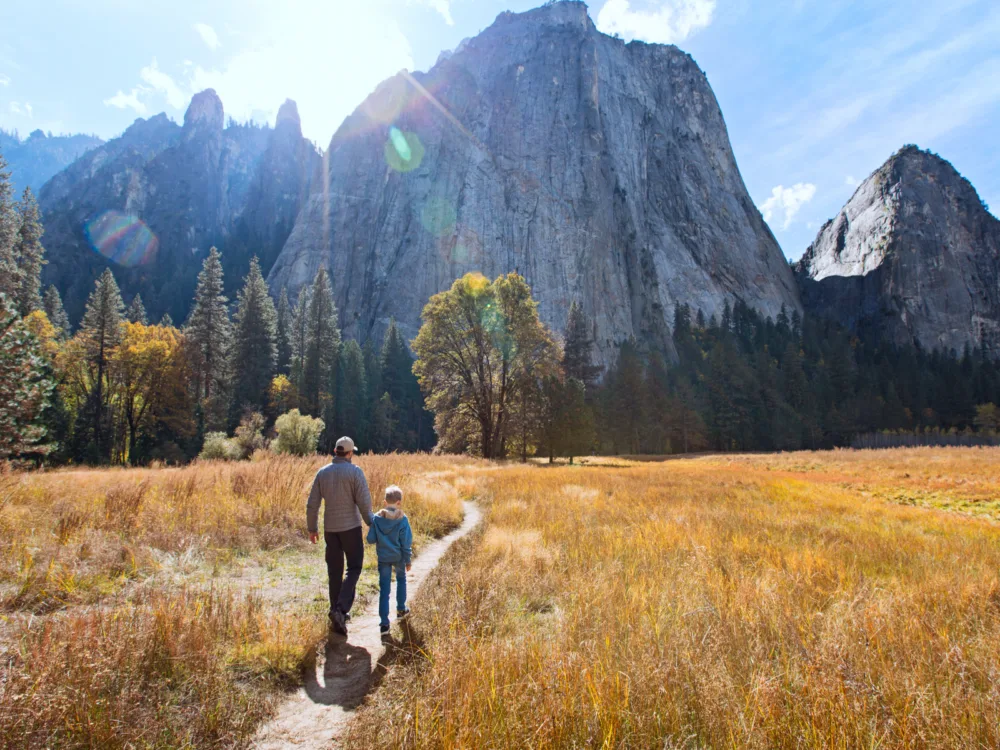
The cheapest time to visit Yosemite is during its low season, from October through February. It can be pretty wet and rainy during the low season, but there are plenty of indoor activities and attractions to keep you busy when the rainfall prevents outdoor exploration.
The chillier fall and winter seasons see fewer visitors in the park, seasonal road and area closures in the park take effect (as well as discounted rates on lodging and activities), and the park’s Badger Pass ski area provides tons of activities and entertainment for winter visitors.
October to February is the cheapest time to visit because more of the park is closed down during the fall and winter than during the peak season.
You’ll find that it’s a lot easier to find vacant rooms to book in all of the in-park lodges during this time of year. And the rates at most lodges are deeply discounted beginning in October, with even bigger discounts available in the winter months.
You’ll pay almost $60 less per night at most of the in-park lodges from October to February. Camping in the park instead will save you a lot of money if you can handle the chill.
Nearby hotels, motels, and Airbnbs outside of the park can present other cheap options for your stay. You can’t really get around the required $35 entry fee (good for 7 days) except on fee-free days like Veteran’s Day (November 11) and Martin Luther King, Jr. Day (mid-January).
As far as activities go, you’ll have plenty of options with skiing, snowboarding, showshoeing, ice skating, ranger-led hikes, snow tubing, and winter camping available in the park during the colder months.
The Badger Pass ski area offers discounts on weekdays and reduced rates for kids and seniors. Children under 6 are free! Take advantage of the free shuttle that will bring you from Yosemite Valley up to the resort.
Least Busy Time to Visit Yosemite
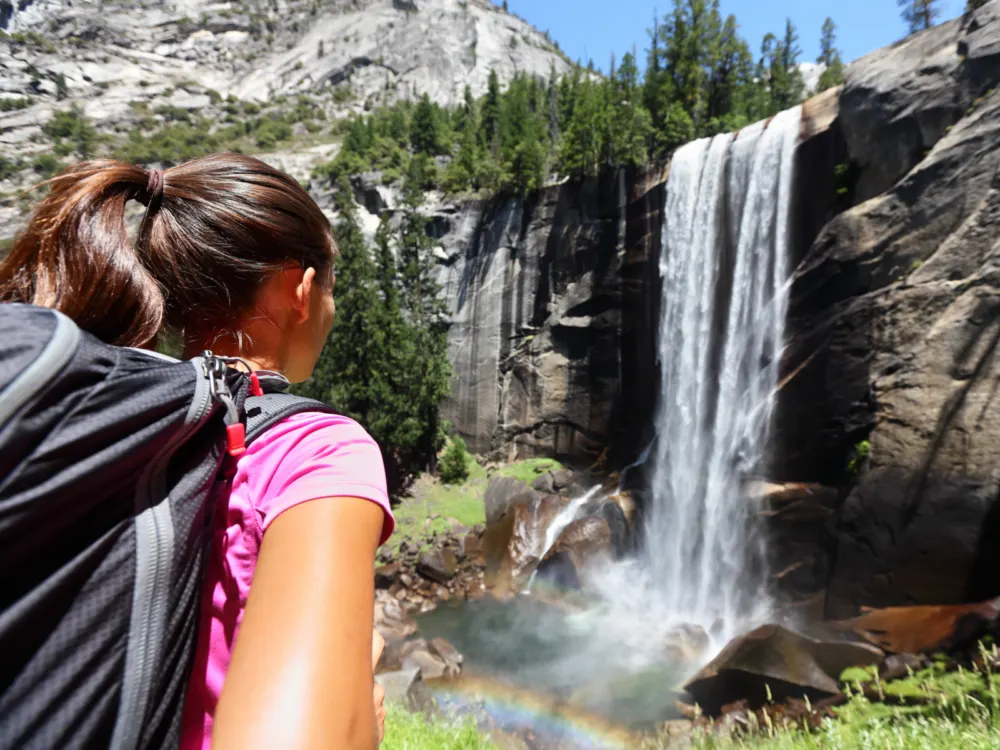
Maridav/Shutterstock
The least busy time to visit Yosemite is December through February, except for the end of December (when holiday travelers arrive). January is the least busy month of all. This period is when Yosemite receives most of its precipitation in the form of rain and snow.
The temperatures dive down to highs around 50F and lows around -2F in the valley with cooler temps at higher elevations. As a result, some areas of the park and roads within the park are closed for the season during this time.
But for a traveler seeking the smallest crowds, these factors won’t be a problem – they’re the reason so few venture to Yosemite at this time of year!
The falls are a-flowin’ after being energized with all the rain and snowfall from the fall and winter months. It’s cold in the park, so it can make camping a little more challenging, but the in-park lodging options provide a warm and cozy haven to get away from the chill.
Still, 4 campgrounds remain open during winter for those who love a challenge and lodging areas near the entrances are open year-round. The Badger Pass ski area is open from mid-December to March for skiing, snowboarding, snowshoeing, and snow tubing.
Ice skate at the Curry Village rink, hike to Mirror Lake, or take time to check out the Yosemite Museum and visitor center to get out of the cold without dealing with big crowds.
Worst Time to Visit Yosemite
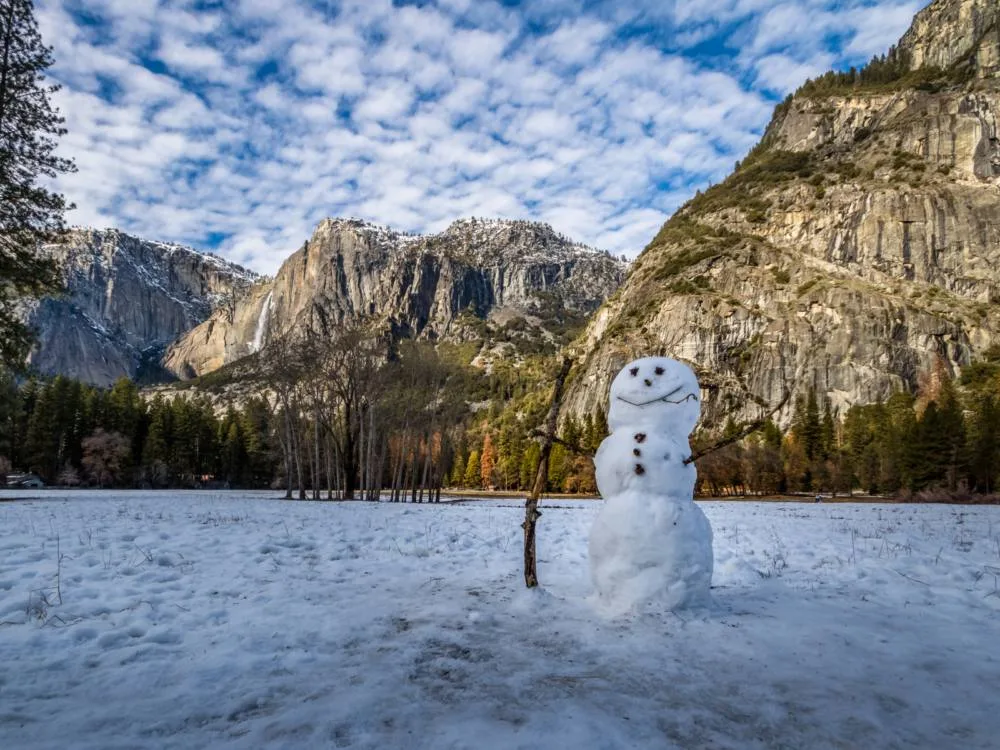
Diego Grandi/Shutterstock
- July and August are the worst months to visit
- Crowds and temperatures are at their peak
- Limited lodging availability + higher prices
We’ve looked at the best time to visit Yosemite, so it’s only right to pay attention to the worst time to go – July and August, as it turns out.
These are the hottest months of the year in Yosemite National Park and the busiest in terms of visitors. You’ll battle the biggest crowds, struggle to achieve clear views at the vantage points, and deal with stifling heat on the trails during this time.
Since July and August are the height of the peak season, this is when most travelers descend on Yosemite. The in-park lodging gets booked up quickly, leaving very few (or no) vacancies for last-minute travelers.
As a result, the rates on rooms, campsites, and canvas tents go up. So you’ll end up paying more for this hot, crowded experience in Yosemite.
On the bright side, everything in the park is open and in full swing with no road, trail, or park service closures during this time. You’ll be able to freely access everything within the park, but you’ll have to decide if braving the crowds and heat is worth it!
Yosemite by Month: Climate & Activities
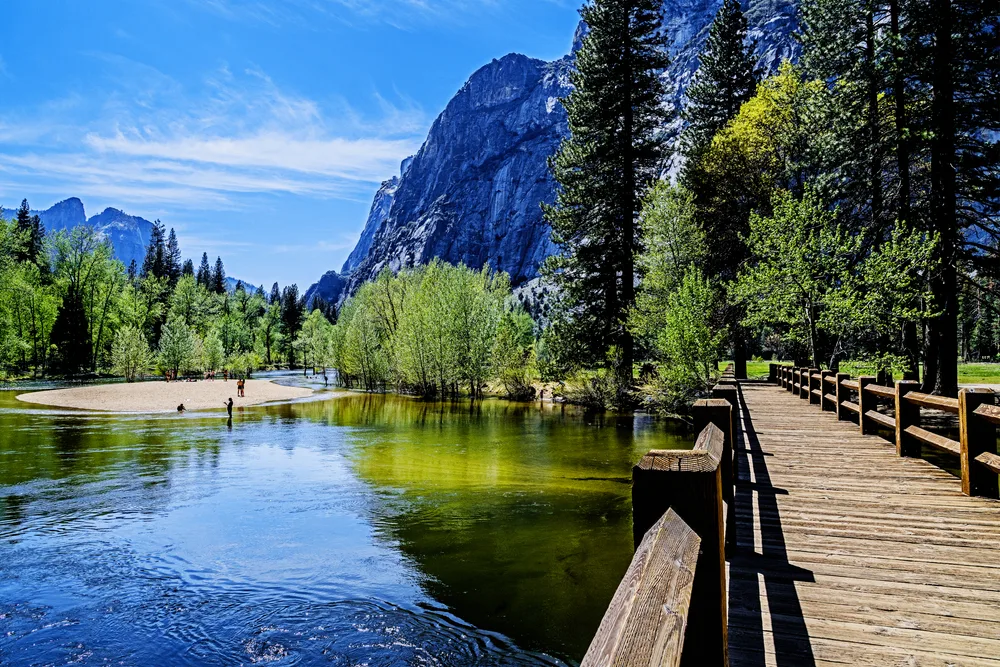
Randy Andy/Shutterstock
Still unsure about the best time to visit New York City? Take a look at our summary of the weather and climate by month below:
January
Winter blankets Yosemite in snow, with temperatures ranging from 28-47°F. It’s a serene time to witness the park’s iconic granite cliffs and waterfalls covered in snow. Skiing, snowshoeing, and winter photography are popular activities.
February
Similar to January, February maintains winter conditions with temperatures between 29-49°F. Winter sports enthusiasts can enjoy cross-country skiing and snowboarding, while the valley’s waterfalls may begin to thaw.
March
As winter transitions to spring, temperatures range from 32-54°F. March marks the start of the waterfall season as snow begins to melt, creating impressive flows. Hiking trails start to reopen, providing opportunities for early spring exploration.
April
Yosemite’s spring arrives with temperatures between 36-61°F. Waterfalls peak during April, and wildflowers start to bloom, adding color to the landscape. Lower elevations become accessible for hiking and outdoor activities.
May
May sees temperatures ranging from 43-70°F. Meadows are lush, and high-country trails begin to open. It’s an ideal time for hiking before the summer crowds arrive, and the waterfalls continue to flow.
June
Summer in Yosemite begins with temperatures between 50-80°F. All areas of the park are accessible, and high-country trails are in full swing. Outdoor activities include rock climbing, camping, and exploring the diverse ecosystems.
July
July maintains warm temperatures ranging from 57-88°F. Summer is in full swing, making it the busiest season. Visitors can enjoy hiking, rock climbing, and ranger-led programs while taking in the spectacular views.
August
August in Yosemite sees temperatures between 57-89°F. It’s a great time for camping, stargazing, and enjoying the park’s diverse wildlife. Popular destinations like Half Dome and Glacier Point are accessible.
September
Fall arrives with temperatures ranging from 49-80°F. Crowds begin to thin, and fall foliage starts to appear. Hiking is still popular, and the waterfalls may still flow, albeit at a reduced volume.
October
October temperatures range from 40-69°F. Fall colors peak in Yosemite Valley, creating a picturesque landscape. It’s a quieter time to explore the park before winter arrives, and some higher elevations may see snow.
November
As winter approaches in Yosemite, temperatures range from 31-56°F. Some facilities begin to close, but it’s still possible to enjoy the park with fewer crowds. Snow may dust the higher elevations, adding to the scenic beauty.
December
Winter returns with temperatures between 27-47°F. Yosemite transforms into a winter wonderland, offering opportunities for snowshoeing, cross-country skiing, and enjoying the peaceful solitude of the park. Some areas may be inaccessible due to snow, but iconic views like El Capitan and Half Dome remain awe-inspiring.
Things to Consider
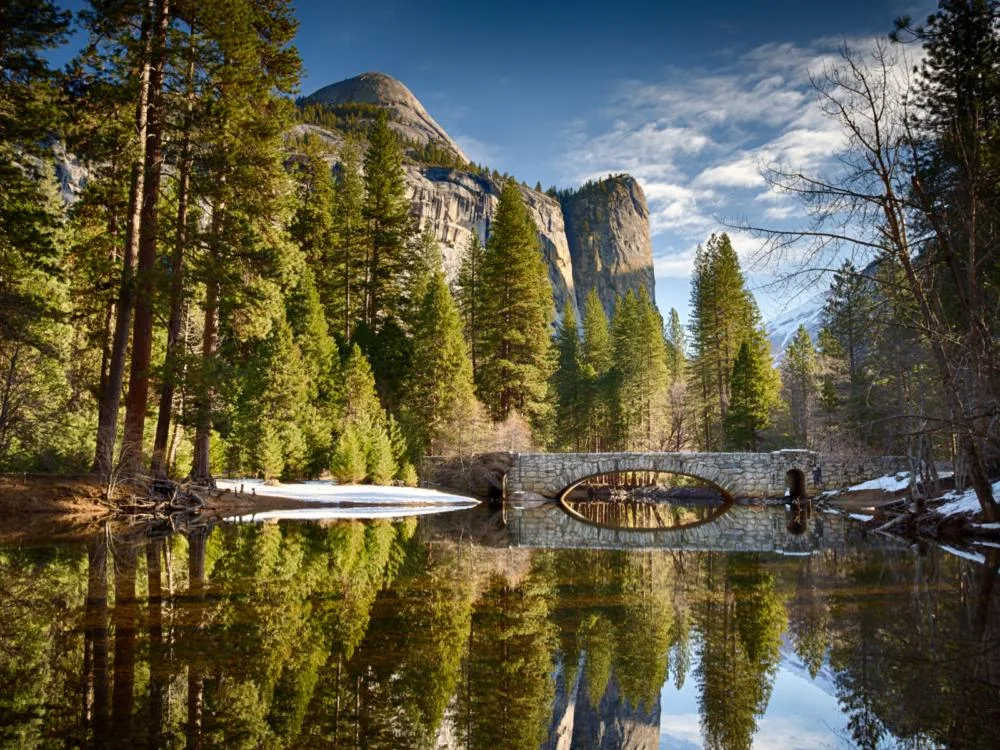
Sarah Fields Photography/Shutterstock
What else should you know to plan the best Yosemite trip possible? Take these tips into consideration to make the most of your Yosemite adventure!
- Consider camping in the park. Camping is cheaper than staying at any of the in-park lodging and is a great way to experience the park a little more up-close. Yosemite has 13 campgrounds within the park, and 4 of them stay open year-round (just pack plenty of blankets and cold weather gear in winter). Your family will enjoy camping at this beautiful park and you’ll save a lot of money on lodging!
- Stay informed about seasonal closures. Yosemite closes certain roads, trails, and services down in the late fall and winter as snow begins to fall and temperatures drop. Tioga Road (the only road that connects the entire park) is closed from November to May each year. Some of the lodging options and campgrounds shut down around October and reopen around April. Free busses and shuttles in the park may be closed during the winter, so be sure to check ahead to see what’s open before you plan your trip.
- Know about the tire chain requirements. If you plan to visit during the colder months – usually November through March – tire chains are required in Yosemite. The snow and ice conditions within the park can occur suddenly, so don’t travel here in winter without tire chains to ensure safety and better control on the roads. Stick to the warmer months and use the lower-elevation entry points (like the El Portal Road) during late fall or early spring to get around the tire chain requirements.
- Reservations are required in peak season. With so much traffic entering the park during the peak season, Yosemite requires reservations for those who aren’t staying in the park’s lodging or campgrounds. You need the 3-day reservation ($2 fee) in advance before you enter the park from May 20 through September 30, but only if you enter between 6AM and 4PM. Try to make reservations at least 7 days before your trip here. You’ll still have to pay the separate entry fee when you arrive.
- Expect to pay an entry fee. Yosemite charges most visitors an entry fee of $35 year-round that’s good for 7 days. Motorcyclists pay $30 to enter, and individuals arriving on foot or bike pay $20 (free if you’re under 15). Exceptions include veterans with a free annual pass, anyone with an annual or lifetime pass, 4th graders arriving as part of the Every Kid Outdoors program, and fee-free entry days (4-5 each year). Learn more here.
- Do as many activities as you can. Yosemite offers tons of activities and attractions for all ages and abilities. Hiking, rafting, fishing, rock climbing, horseback riding, bird and wildlife watching, stargazing, backpacking, camping, photography, guided hikes and tours, museum and visitor center exploration, in-park dining and picnics, skiing, snowboarding, and ice skating are all available to you when you visit. Do as many activities as you can to pack your Yosemite trip with memories!
Best Time to Visit Yosemite: Final Thoughts
| 👍 Best Time to Visit | May-September |
| 💲 Cheapest Time to Visit | October-February |
| 🗓️ Least Busy Time to Visit | December-February |
| 👎 Worst Time to Visit | July-August |
Overall, the best time to visit Yosemite is between May and September, with the bookend months (May, June, and September) being the absolute ideal time to go.
The weather is warm and dry, the park is 100% open and alive with activity, and the stunning falls within the park are flowing powerfully. It’s truly the best time of year to see Yosemite in all its wonder!
With iconic views of mega granite domes and cliffs, groves of giant ancient sequoias, lush valleys filled with plants and unique wildlife, and cascading waterfalls among the tallest in the world, Yosemite is definitely, positively, absolutely worth seeing.
But Yosemite isn’t the only national park that belongs on your travel bucket list! Check out 21 Best National Parks in the USA in 2022 next to learn about the other natural gems in the U.S.



